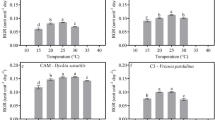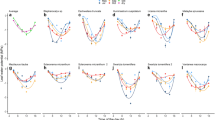Abstract
The photosynthetic characteristics of a giant alpine plant, Rheum nobile Hook. f. et Thoms. and of some other alpine species were studied in situ at 4300 m, in the Eastern Himalaya, Nepal, during the summer monsoon season. Although rainy and overcast weather was predominant, the daytime photon flux density (400–700 nm) ranged from 300 to 500 μmol quanta m-2 s-1. Under such conditions, the temperature of leaves of R. nobile ranged from 10 to 14°C, and the rate of photosynthetic CO2 exchange ranged from 10 to 16 μmol CO2 m-2 s-1. The ratios of the maximum rate of photosynthetic CO2 fixation to leaf nitrogen content (defined as instantaneous nitrogen-use efficiency, NUE) for the Himalayan forbs that were examined in situ were similar to the NUE values reported for lowland herbaceous species examined under lowland conditions. In contrast to the common belief, theoretical calculations indicate that the decrease in the rate of photosynthesis due to low atmospheric pressure is small. These Himalayan forbs appeared to overcome this small disadvantage by increasing stomatal conductance. Suppression of photosynthesis caused by blockage of stomata by raindrops appeared to be avoided by either of two mechanisms: plants had large hypostomatous leaves that expanded horizontally or they had obliquely oriented amphistomatous leaves without bundle sheath extensions. All these observations indicate that the gas-exchange characteristics of alpine forbs in the Eastern Himalaya are adapted to the local wet and humid monsoon conditions and thus photosynthetic rates attained during the monsoon period are similar to those of lowland plants.
Similar content being viewed by others
References
Berry J, Björkman O (1980) Photosynthetic response and adaptation to temperature in higher plants. Annu Rev Plant Physiol 31:491–543
Billings WD, Mooney HA (1968) The ecology of arctic and alpine plants. Biol Rev 43:481–529
Brooks A, Farquhar GD (1985) Effects of temperature on the CO2/O2 specificity of ribulose 1,5-bisphosphate carboxylase/oxygenase and the rate of respiration in the light. Planta 165:397–406
Caemmerer S von, Farquhar GD (1981) Some relationships between the biochemistry of photosynthesis and the gas exchange of leaves. Planta 153:376–387
Cowan IR (1982) Regulation of water use in relation to carbon gain in higher plants. In: Lange OL, Nobel PS, Osmond CB, Ziegler H (eds) Encyclopedia of Plant Physiology, New Series Vol 12B, Springer, Berlin, pp 589–613
Evans JR, Seemann JR (1989) The allocation of protein nitrogen in the photosynthetic apparatus: cost, consequences, and control. In: Briggs WR (ed) Photosynthesis. Alan R Liss, New York, pp 183–205
Farquhar GD, Caemmerer S von, Berry JA (1980) A biochemical model of photosynthetic CO2 assimilation in leaves of C3 species. Planta 149:78–90
Farquhar GD, O'Leary MH, Berry JA (1982) On the relationship between carbon isotope discrimination and the intercellular carbon dioxide concentration in leaves. Aust J Plant Physiol 9:121–137
Friend AD, Woodward FI (1990) Evolutionary and ecophysiological responses of mountain plants to the growing season environment. Adv Ecol Res 20:59–124
Friend AD, Woodward FI, Switsur VR (1989) Field measurements of photosynthesis, stomatal conductance, leaf nitrogen and δ13C along altitudinal gradients in Scotland. Funct Ecol 3:117–122
Gebauer G, Rehder H, Wollenweber B (1988) Nitrate, nitrate reduction and organic nitrogen in plants from different ecological and taxonomic groups of Central Europe. Oecologia 75:371–385
Grantz DA (1990) Plant response to atmospheric humidity. Plant Cell Environ 13:667–679
Hall AE, Schulze ED, Lange OL (1976) Current perspective of steady-state stomatal responses to environment. In: Lange OL, Kappen L, Schulze ED (eds) Water and plant life. Springer, Berlin, pp 169–188
Hikosaka K, Okada K, Terashima I, Katoh S (1993) Acclimation and senescence of leaves: their roles in canopy photosynthesis. In: Yamamoto H (ed) Photosynthetic responses to the environment. American Society of Plant Physiologists, Lancaster, in press
Hirose T, Werger MJA (1987) Nitrogen use efficiency in instantaneous and daily photosynthesis of leaves in the canopy of a Solidago altissima stand. Physiol Plant 70:215–222
Jordan DB, Ogren WL (1984) The CO2/O2 specificity of ribulose 1,5-bisphosphate carboxylase/oxygenase. Planta 161:308–313
Kikuchi T, Ohba H (1988) Daytime air temperature and its lapse rate in the monsoon season in a Himalayan high mountain region. In: Ohba H, Malla SB (eds) The Himalayan plants, vol 1. University of Tokyo Press, Tokyo, pp 11–18
Körner C (1989) The nutritional status of plants from high altitudes. A worldwide comparison. Oecologia 81:379–391
Körner C, Diemer M (1987) In situ photosynthetic responses to light, temperature and carbon dioxide in herbaceous plants from low and high altitude. Funct Ecol 1:179–194
Körner C, Larcher W (1988) Plant life in cold climates. In: Long SP, Woodward FI (eds) Plants and temperature. Society for Experimental Biology, Cambridge, pp 25–57
Körner C, Scheel JA, Bauer H (1979) Maximum leaf diffusive conductance in vascular plants. Photosynthetica 13:45–82
Körner C, Allison A, Hilscher H (1983) Altitudinal variation of leaf diffusive conductance and leaf anatomy in heliophytes of montane New Guinea and their interrelation with microclimate. Flora 174:91–135
Körner C, Farquhar GD, Roksandic Z (1988) A global survey of carbon isotope discrimination in plants from high altitude. Oecologia 74:623–632
Körner C, Farquhar GD, Wong SC (1991) Carbon isotope discrimination by plants follows latitudinal and altitudinal trends. Oecologia 88:30–40
Lancaster R (1981) Plant hunting in Nepal. Croom Helm, London
Lange OK, Lösch R, Schulze ED, Kappen L (1971) Responses of stomata to changes in humidity. Planta 100:76–86
Larcher W (1980) Physiological plant ecology, 2nd edn. Springer, Berlin
Li-Cor (1987) LI-6200 Technical reference manual. Li-Cor, Lincoln
Leuring R, Sands P (1989) Theory and practice of a portable photosynthesis instrument. Plant Cell Environ 12:669–178
Maier-Maercker U (1979) Peristomatal transpiration and stomatal movement: A controversial view. I. Additional proof of peristomatal transpiration by hygrophotography and a comprehensive discussion in the light of recent results. Z Pflanzenphysiol 91:25–34
Mani MS (1978) Ecology and phytogeography of high altitude plants of the northwest Himalaya. Introduction to high altitude botany. Chapman and Hall, London
McDermitt DK, Norman JM, Davis JT, Ball TM, Arkebauer TJ, Wellew JM, Roemer SR (1989) CO2 response curves can be measured with a field-portable closed-loop photosynthesis system. In: Dryer E (ed) Forest tree physiology. Elsevier/INRA, Amsterdam, pp 416S-420S
Meinzer FC, Goldstein GH, Rundel PW (1985) Morphological changes along an altitude gradient and their consequences for an Andean giant rosette plant. Oecologia 65:278–283
Monteith JL (1973) Principles of environmental physics. Arnold, London
Mott KA, Gibson AC, O'Leary JW (1982) The adaptive significance of amphistomatous leaves. Plant Cell Environ 5:455–460
Mott KA Parkhurst DF (1991) Stomatal responses to humidity in air and helox. Plant Cell Environ 14:509–515
Ohba H (1988) The alpine flora of the Nepal Himalayas: An introductory note. In Ohba H, Malla SB (eds) The Himalayan plants, vol 1. University of Tokyo Press, Tokyo, pp 19–46
Ohba H, Akiyama S (1992) The alpine flora of the Jaljale Himal, East Nepal. The University Museum, the University of Tokyo, Tokyo
Parkhurst DF, Mott KA (1990) Intercellular diffusion limits to CO2 uptake in leaves. Plant Physiol 94:1024–1032
Parkhurst DF, Wong SC, Farquhar GD, Cowan IR (1986) Gradients of intercellular CO2 levels across the leaf mesophyll. Plant Physiol 86:1032–1037
Sage RF, Pearcy RW (1987) The nitrogen use efficiency of C3 and C4 plants II. Leaf nitrogen effects on the gas exchange characteristics of Chenopodium album L. and Amaranthus retroflexus L. Plant Physiol 84:959–963
Schulze ED, Beck E, Scheibe R, Ziegler P (1985) Carbon dioxide assimilation and stomatal response of afroalpine giant rosette plants. Oecologia 65:207–213
Shrestha TB (1989) Development ecology of the Arun river basin in Nepal. International Centre for Integrated Mountain Development, Kathmandu
Smith AP, Young TP (1987) Tropical alpine plant ecology. Annu Rev Ecol Syst 18:137–158
Smith WK, McClean TM (1989) Adaptive relationship between leaf water repellency, stomatal distribution, and gas exchange. Am J Bot 76:465–469
Terashima I (1992) Anatomy of non-uniform leaf photosynthesis. Photosyn Res 31:195–212
Terashima I, Wong SC, Osmond CB, Farquhar GD (1988) Characterisation of non-uniform photosynthesis induced by abscisic acid in leaves having different mesophyll anatomies. Plant Cell Physiol 29:385–394
Tranquillini W (1964) The physiology of plants at high altitudes. Annu Rev Plant Physiol 15:345–362
Yoshie F (1986) Intercellular CO2 concentration and water-use efficiency of temperate plants with different life-forms and from different microhabitats. Oecologia 69:370–174
Author information
Authors and Affiliations
Rights and permissions
About this article
Cite this article
Terashima, I., Masuzawa, T. & Ohba, H. Photosynthetic characteristics of a giant alpine plant, Rheum nobile Hook. f. et Thoms. and of some other alpine species measured at 4300 m, in the Eastern Himalaya, Nepal. Oecologia 95, 194–201 (1993). https://doi.org/10.1007/BF00323490
Received:
Accepted:
Issue Date:
DOI: https://doi.org/10.1007/BF00323490




